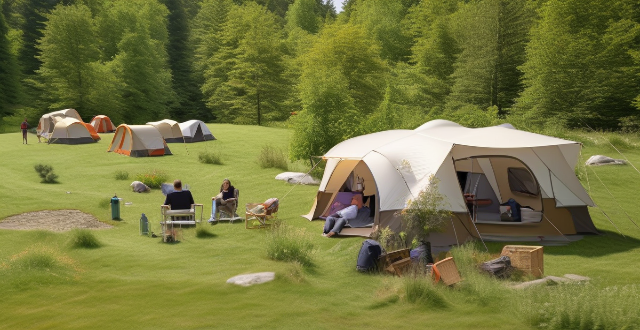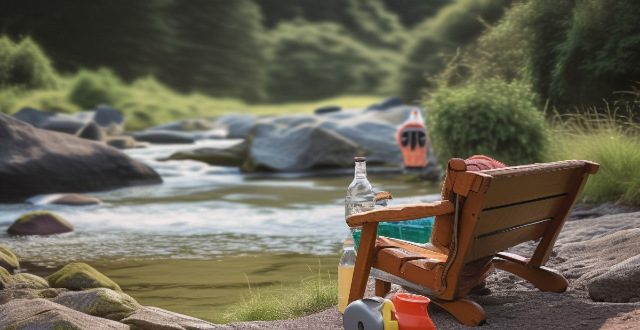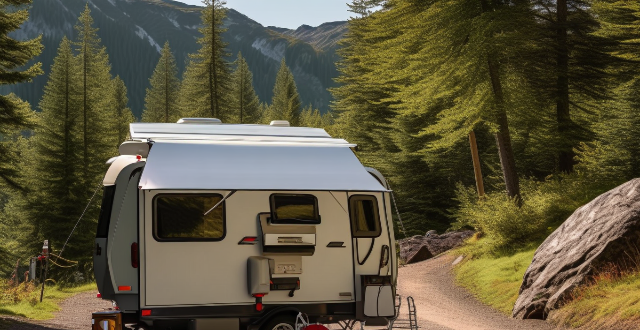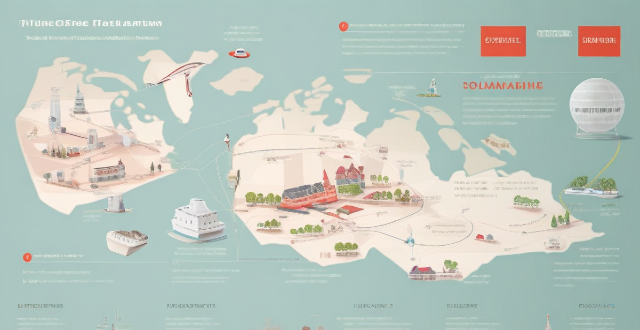Travel Adventure

What are the benefits of participating in adventure travel activities ?
Adventure travel activities offer various benefits that positively impact physical, mental, and emotional well-being. These activities improve cardiovascular fitness, muscle strength, and weight management. They also reduce stress, boost self-confidence, and enhance creativity and problem-solving abilities. Adventure travel activities foster social interaction, personal growth, and improved mood and happiness.

How can I stay safe during adventure travel activities ?
Adventure travel activities can be exciting and thrilling, but they also come with certain risks. To ensure your safety during these activities, it's important to take necessary precautions and follow some basic guidelines. Here are some tips on how to stay safe during adventure travel activities: 1. Research and plan ahead before embarking on any adventure travel activity. Check the weather conditions, terrain, and potential hazards. 2. Choose reputable operators for your adventure travel activity. Look for operators that are licensed, insured, and adhere to safety standards. 3. Follow safety guidelines provided by the operator during the activity. Wear protective gear such as helmets, harnesses, or life jackets. 4. Make sure you are physically fit and healthy enough to participate in the adventure travel activity. If you have any pre-existing medical conditions or injuries, consult with a doctor beforehand. 5. Pack essential gear and supplies for the adventure travel activity, including appropriate clothing, footwear, sunscreen, insect repellent, and first aid kit. 6. Stay alert and attentive during the adventure travel activity. Keep an eye out for potential hazards such as uneven terrain, loose rocks, or changing weather conditions. 7. Use common sense and trust your instincts during the adventure travel activity. If something feels too risky or dangerous, don't hesitate to back out or seek assistance from the guides or other participants. By following these tips, you can minimize the risks associated with adventure travel activities and enjoy a safe and memorable experience.

What are the best adventure travel destinations ?
Adventure travel is a great way to explore the world and experience new things. Here are some of the best adventure travel destinations: 1\. New Zealand: Known for its stunning landscapes and outdoor activities, including hiking, skiing, and kayaking. 2\. Costa Rica: Offers lush rainforests, volcanoes, beaches, and top activities such as surfing, zip-lining, and whitewater rafting. 3\. Iceland: A land of fire and ice, with glaciers, volcanoes, hot springs, and top activities like whale watching, glacier hiking, and snowmobiling. 4\. Nepal: A trekker's paradise, with towering Himalayan peaks and diverse landscapes, offering activities like trekking, paragliding, and whitewater rafting. 5\. Patagonia (Argentina and Chile): Known for its rugged landscapes and outdoor adventures, including hiking, mountain biking, and kayaking.

What should I pack for an adventure travel activity ?
Adventure travel activities can be thrilling and exciting, but it's important to pack the right gear to ensure your safety and comfort. Here are some essential items to consider packing for your next adventure: - Clothing: A waterproof jacket with a high waterproof rating and breathability is essential for outdoor activities in wet conditions. Quick-dry shirts and pants that are comfortable to move in and suitable for the climate you'll be traveling in are ideal. Comfortable shoes or boots that provide support, traction, and comfort are also important. Pack warm layers like a fleece jacket or sweater for cooler temperatures. - Gear: Choose a backpack that's comfortable to wear and has enough space for all your gear. A headlamp or flashlight is essential for navigating in the dark or during power outages. Pack extra batteries or a charger to ensure you have enough light throughout your trip. A well-stocked first aid kit with bandages, antiseptic wipes, pain relievers, and any prescription medications you may need is important. A multi-tool can come in handy for various tasks. - Other Essentials: A reusable water bottle and a water filter or purification tablets are crucial for staying hydrated. High-energy snacks and food that are easy to carry and won't spoil quickly are great options for fueling up during your adventure. Reliable navigation tools like a map, compass, or GPS device are essential for finding your way in unfamiliar terrain. By packing these essential items, you'll be prepared for whatever challenges come your way during your adventure travel activity. Remember to also check the weather forecast and any specific requirements for your destination to ensure you have everything you need for a safe and enjoyable trip.

What are the best places to go for adventure travel in Asia ?
Asia is a continent filled with diverse cultures, breathtaking landscapes, and thrilling adventures. Whether you're seeking adrenaline-pumping activities or off-the-beaten-path explorations, Asia has something to offer every type of adventure traveler. Here are some of the best places to go for adventure travel in Asia: 1. Nepal - Trekking and Mountaineering 2. Thailand - Island Hopping and Water Sports 3. Vietnam - Motorbiking and Rock Climbing 4. Indonesia - Volcano Hiking and Diving 5. Japan - Skiing and Hot Springs

What are the most popular adventure travel activities ?
Adventure travel is a popular choice for tourists seeking thrilling experiences and exploration. Here are some of the most sought-after adventure activities: 1. **Hiking and Trekking** - Explore remote locations or national parks through multi-day treks, day hikes, or guided walks. 2. **Scuba Diving and Snorkeling** - Dive into coral reefs, explore underwater wrecks, or witness nocturnal marine life. 3. **Mountaineering and Rock Climbing** - Ascend iconic peaks, climb renowned rock formations, or try bouldering in unique landscapes. 4. **Rafting and Kayaking** - Experience whitewater rafting on challenging rivers, sea kayak around coastlines, or enjoy flatwater kayaking on serene waters. 5. **Cycling and Mountain Biking** - Enjoy road cycling through scenic routes, mountain biking on rugged trails, or combine camping with bikepacking adventures. 6. **Safari and Wildlife Watching** - Go on game drives in African safari destinations, jungle treks for wildlife spotting, or whale watching expeditions. 7. **Paragliding and Skydiving** - Try tandem skydives over stunning landscapes, paraglide from mountaintops, or engage in BASE jumping at designated sites. 8. **Surfing and Kitesurfing** - Surf iconic waves, kiteboard in windy locations, or stand-up paddleboard (SUP) on calm waters or during downwinders. 9. **Caving and Spelunking** - Explore cave systems, spelunk in well-equipped underground environments, or dive into underwater caves for an extreme challenge. 10. **Snowsports** - Experience heli-skiing in remote mountain ranges, backcountry skiing for untouched slopes, or snowmobiling across vast frozen landscapes. These activities cater to various levels of experience and adventurousness, offering travelers unforgettable experiences that combine excitement, physical challenge, and the beauty of natural environments.

What are some unique adventure travel activities to try ?
Adventure travel activities offer a range of unique experiences, from skydiving for aerial views to caving for underground exploration. Kayak in fjords to spot marine life, or camel trek across deserts for serene nights under the stars. Volcano boarding and shark cage diving provide thrilling encounters with nature's power. Heli-hiking combines helicopter transport with remote wilderness hikes, while snowmobiling offers high-speed adventures on snowy terrains. Hot air ballooning provides a peaceful aerial journey with champagne toasts at dawn or dusk. Lastly, snuba diving merges snorkeling and scuba diving for easy underwater exploration.

What should I look for in a travel insurance policy for adventure activities ?
When selecting a travel insurance policy for adventure activities, there are several key factors to consider, including coverage for specific sports and equipment, medical and evacuation coverage, trip interruption and cancellation, baggage and personal effects, liability coverage, and customer service and support. By considering these factors, you can choose a policy that will give you peace of mind and financial protection during your exciting adventures abroad.

How do I choose the right backpack for a European travel adventure ?
Choosing the right backpack for a European travel adventure involves considering factors such as destination climate and duration, capacity and organization, comfort and fit, durability and material, and style and personalization. Key considerations include selecting a backpack with ample insulation for cooler regions, choosing one with multiple pockets and compartments for efficient organization, opting for padded straps and adjustable hip belts for comfort, selecting water-resistant materials for durability, and choosing a design that reflects personal style. By taking these factors into account, travelers can ensure they have a comfortable, convenient, and organized backpack for their European adventure.

How do I plan an adventure travel activity ?
Planning an adventure travel activity requires careful planning and preparation to ensure a safe and enjoyable trip. Here are some steps to help you plan your next adventure travel activity: 1. Determine your budget before starting any planning. 2. Choose your destination and research popular destinations for adventure travel. 3. Research different adventure activities available at your chosen destination. 4. Book accommodations and transportation, looking for deals and discounts if possible. 5. Pack appropriate gear for your adventure activities, checking with the activity provider for specific requirements and recommendations. 6. Plan for emergencies while traveling, bringing a first aid kit and knowing the location of nearby medical facilities. 7. Stay connected with friends and family while on your trip, letting them know your itinerary and checking in regularly. 8. Finally, remember to have fun and enjoy your adventure travel activity!

What are the risks involved in adventure travel activities ?
Adventure travel activities come with risks like physical injuries, altitude sickness, encounters with wildlife, extreme weather conditions, natural disasters, foodborne illnesses, heatstroke, transportation issues, language barriers, high costs, lack of travel insurance, cultural shock, and loneliness. It is important to assess these risks before embarking on any adventure travel activity and take necessary precautions.

What are the best practices for packing light for a road trip adventure ?
Packing light for a road trip adventure is key to enjoying the journey without being weighed down by excess baggage. Best practices include planning outfits in advance, using packing cubes or compression sacks, rolling clothing instead of folding, sticking to a color scheme, opting for travel-size toiletries, wearing bulkiest items on the plane, and limiting accessories. By following these tips, you can ensure an enjoyable and stress-free road trip adventure.

How much does it cost to participate in adventure travel activities ?
Adventure travel activities can vary in cost based on the activity, location, duration, and level of difficulty. Factors such as accommodations, meals, transportation, and guides/tours can also impact the overall cost. It is important to research and plan carefully to ensure a budget-friendly and enjoyable experience.

What are the best travel destinations for adventure seekers ?
The text provides a summary of the best travel destinations for adventure seekers, including New Zealand, Costa Rica, Iceland, Tanzania, and Patagonia (Argentina & Chile). Each destination offers a range of thrilling activities such as bungee jumping, skydiving, white-water rafting, hiking, skiing, zip-lining, surfing, rafting, canopy tours, hot spring bathing, safari, scuba diving, snorkeling, rock climbing, trekking, skiing, kayaking, horseback riding, and mountain biking.

Is there an age limit for buying travel insurance ?
Is there an age limit for buying travel insurance? Most providers do not impose any restrictions based on age, but some policies may have specific requirements or limitations regarding age. When purchasing travel insurance, consider factors such as coverage options, pre-existing medical conditions, adventure sports coverage, cost, and reputation.

What are some tips for traveling alone during adventure travel activities ?
Tips for traveling alone during adventure travel activities include researching your destination, packing appropriately, staying connected with friends and family, being aware of your surroundings, joining a tour group, and trusting your instincts.

What does a typical travel insurance cover ?
Travel insurance typically covers medical expenses, trip cancellation and interruption, baggage loss and delay, accidental death and dismemberment, and emergency assistance services. Optional extras may include coverage for sports and adventure activities, rental car damage, and travel delay. It's important to consider the specific needs of your trip when selecting a policy and to carefully read the details to understand coverage limits and exclusions.

Are there any specific toiletries I need to bring for a camping adventure ?
When embarking on a camping adventure, it's important to pack the essential toiletries to ensure you stay clean and comfortable throughout your trip. Here are some specific items you should consider bringing: - Personal Hygiene Items such as toothbrush and toothpaste, soap or body wash, shampoo and conditioner, deodorant, razor and shaving cream, tissues or toilet paper, hand sanitizer, sunscreen, insect repellent, lip balm with SPF, and feminine hygiene products. - Hair Care Items like comb or brush, hair ties or clips, dry shampoo, hairbands or headscarves. - Oral Care Items including dental floss, mouthwash, tongue scraper, toothpicks. - Foot Care Items such as nail clippers or scissors, moleskin or bandages, foot powder, shoe deodorizers. - Miscellaneous Items like earplugs, eye mask, small mirror, travel pillow, wet wipes, first aid kit, laundry soap or detergent tablets, sewing kit, baby powder or cornstarch, extra plastic bags or compression sacks. Remember to pack these items in waterproof bags to protect them from moisture, and consider investing in reusable containers to reduce waste. With this comprehensive list, you'll be well-prepared for your next camping adventure!

What is the best travel insurance for international trips ?
When it comes to choosing the best travel insurance for international trips, there are several factors to consider. Look for a policy that covers medical expenses, trip cancellation/interruption, baggage and personal effects, emergency evacuation and repatriation, travel delay and missed connection, and identity theft protection. Consider the deductibles and limits of each coverage type within the policy. Pay attention to exclusions and limitations such as pre-existing conditions, adventure sports and activities, and geographical limitations. Look for a reputable insurer with excellent customer service ratings and a smooth claims process. Compare prices across different insurers and policies to find one that fits your budget without compromising on essential coverage. By taking into account these key points, you can choose a policy that provides adequate protection and peace of mind for your next adventure abroad.

What are the benefits of participating in adventure races ?
Adventure races offer numerous benefits including improved cardiovascular fitness, muscular strength, weight management, stress reduction, enhanced cognitive function, emotional well-being, adventure and fun, personal growth, community involvement, and more. These multi-discipline events challenge participants physically and mentally while promoting overall health and wellness. Whether seeking a thrilling experience, personal development, or simply enjoying nature, adventure races provide an excellent way to achieve these goals while having fun and creating lasting memories.

Are there any age or health restrictions for going on a space travel adventure ?
There are age and health restrictions for going on a space travel adventure. The minimum age is usually 18 years old, while the maximum age varies between providers. Health restrictions include physical fitness tests, mental health evaluations, chronic conditions exclusions, pregnancy prohibitions, recent surgery or injury waiting periods, height restrictions, motion sickness considerations, allergies to materials used in spacecraft construction or supplies carried on board, and drug use disqualifications. These restrictions help ensure the safety and well-being of all participants involved in this exciting but challenging endeavor.

Is space travel only for astronauts or can ordinary people go too ?
Space travel, once a distant dream, has become a reality with the advent of commercial spaceflight companies. However, the question remains: is space travel only for astronauts or can ordinary people go too? In the early days of space exploration, only highly trained astronauts were selected to venture into space. These individuals underwent rigorous training and selection processes to ensure their physical and mental fitness for the challenges of spaceflight. Over time, the landscape of space travel has changed significantly. Private companies have entered the arena, offering opportunities for ordinary people to experience spaceflight. This shift has opened up new possibilities for those who dream of exploring the final frontier. Several private companies have emerged in recent years, each with its own approach to space tourism. Some of the key players include Blue Origin, SpaceX, and Virgin Galactic. While space travel may seem like an extravagant luxury, there are several potential benefits for ordinary people who choose to embark on this adventure. These benefits include experiencing weightlessness, viewing Earth from space, and advancing science and technology related to space exploration.

What steps should be taken to maintain good hygiene during travel ?
The text provides a comprehensive guide on maintaining good hygiene during travel. It emphasizes the importance of packing essential hygiene items, keeping hands clean, practicing safe eating habits, staying clean and fresh, being mindful of surroundings, keeping living spaces clean, and following local customs. The article underscores that maintaining good hygiene is crucial to staying healthy and enjoying a pleasant travel experience.

How do I prepare a travel first aid kit for my next trip ?
When preparing for your next adventure, it's essential to pack a travel first aid kit. This will ensure that you are prepared for any unexpected injuries or illnesses that may occur while away from home. Here are some steps to follow when creating your own travel first aid kit: 1. Choose the right bag or container that is durable, compact, and easy to carry. A waterproof bag with multiple compartments and pockets is ideal as it allows for efficient organization of supplies. 2. Pack essential medical supplies such as bandages, antiseptic wipes, gauze pads, adhesive tape, and scissors. These items are crucial for treating cuts, scrapes, and other minor injuries. Include pain relievers, allergy medication, and motion sickness pills. 3. If taking regular medications, bring enough to last throughout the trip. Over-the-counter drugs like antacids, laxatives, and anti-diarrheal pills should also be packed, along with any prescription medications needed. 4. Depending on the destination and activities planned, specialized items may be necessary. For example, insect repellent, sunscreen, and blister kits are useful for hiking or camping trips. Anti-malarial medication and water purification tablets are important for tropical climates. 5. Customize the travel first aid kit based on individual needs. If allergies or chronic conditions exist, include appropriate medications and supplies. Don't forget to pack a small first aid manual or guidebook for reference in case of an emergency.

Is it worth buying travel insurance for domestic trips ?
The article discusses the importance of travel insurance for domestic trips. It suggests that while it may not always be necessary, it can provide an additional layer of protection and peace of mind, especially for those embarking on adventurous or expensive trips. The article provides a list of key points to consider when deciding whether to purchase travel insurance, including risk assessment, coverage details, cost analysis, personal circumstances, and peace of mind. It also lists the benefits of travel insurance for domestic trips, such as medical coverage, trip interruption/cancellation, baggage loss/theft, emergency evacuation, and accidental death and dismemberment. The article concludes by suggesting that the decision to buy travel insurance depends on various factors such as the nature of the journey, existing coverage, and personal preferences.

How do I compare different travel insurance policies ?
The article provides a comprehensive guide on how to effectively compare different travel insurance policies. It outlines four key steps: determining needs, checking coverage and benefits, comparing prices and deductibles, and reading reviews and asking for recommendations. The article emphasizes the importance of considering factors such as destination, duration, activities, health, and budget when determining needs. It also highlights the importance of looking for policies that provide comprehensive coverage for medical expenses, trip cancellation and interruption, baggage loss and delay, emergency evacuation and repatriation, and travel assistance services. Finally, it suggests comparing prices and deductibles and seeking out reviews and recommendations from others to make an informed decision. Overall, the article offers valuable insights into the process of selecting the right travel insurance policy.

What are some strategies for finding discounted travel packages and deals ?
Strategies for Finding Discounted Travel Packages and Deals Traveling can be expensive, but there are several strategies to find discounted travel packages and deals. Being flexible with travel dates, signing up for email alerts and newsletters, using travel rewards programs, looking for bundled packages, checking for last-minute deals, considering alternative accommodations, and researching local discounts and freebies are all effective ways to save money on travel expenses. By employing these strategies, travelers can enjoy memorable adventures without overspending.

How long before my trip should I buy travel insurance ?
Travel insurance is a crucial component of any trip, offering coverage for unexpected events such as medical emergencies, trip cancellations, and lost luggage. The best time to buy travel insurance depends on various factors, including the timing of your purchase, trip details, personal situation, and research. Timing matters when buying travel insurance. It's recommended to buy early for peace of mind, better pricing, and more options. However, waiting too long can increase the risk of forgetting, limit options, and create coverage gaps. Trip details such as destination, length of stay, and activities should also be considered. Personal situation factors like health status, financial protection, and travel companions' needs should also influence the timing of your purchase. Practical steps include researching policies, comparing online, reading reviews, consulting a broker, completing an online application, confirming details, and keeping records. Ideally, travel insurance should be purchased at least a few weeks before the trip to ensure adequate coverage and avoid last-minute stressors.

What are some essential travel safety tips for international tourists ?
Traveling to a foreign country can be an exciting adventure, but it's important to prioritize safety during your journey. Here are some essential travel safety tips for international tourists: ## Research Your Destination Before embarking on your trip, research the destination thoroughly. Familiarize yourself with local customs, laws, and cultural norms. This will help you avoid any misunderstandings or unintentional offenses that could put you in harm's way. ### Learn Basic Phrases in the Local Language Knowing how to say simple phrases like "hello," "goodbye," "thank you," and "I don't understand" in the local language can go a long way in helping you communicate with locals and navigate your way around. ### Check the Weather Forecast Be prepared for any weather conditions by checking the forecast before you leave. Pack appropriate clothing and gear to ensure your comfort and safety throughout your trip. ## Stay Informed About Safety Concerns Stay up-to-date on any safety concerns or travel warnings related to your destination. The U.S. Department of State maintains a website with current information on safety issues and advisories for travelers. ### Register With Your Embassy or Consulate Register your travel plans with your embassy or consulate so they can contact you in case of an emergency or natural disaster. This is especially important if you plan to visit remote areas where communication might be limited. ## Be Cautious With Your Belongings When traveling abroad, it's crucial to take precautions to protect your belongings from theft or loss. Here are some tips to keep your valuables safe: ### Keep Your Valuables Close at Hand Carry only what you need when sightseeing or exploring new places. Keep your passport, cash, credit cards, and other valuables secure in a money belt or hidden pocket. ### Use Hotel Safes Wisely Hotel safes are convenient for storing valuable items while you're out and about. However, be aware that not all hotel safes are foolproof. Some may have vulnerabilities that could allow thieves to access your belongings. Always exercise caution when using hotel safes and consider bringing along a portable lock for added security. ### Be Mindful of Your Surroundings Stay alert and aware of your surroundings at all times. Avoid displaying expensive jewelry or electronics in public places, as these items can attract unwanted attention from pickpockets and thieves. If possible, try to blend in with the local crowd by dressing conservatively and avoiding flashy accessories. ## Follow Local Laws and Customs Respecting local laws and customs is essential for staying safe while traveling abroad. Here are some tips to help you navigate this aspect of international travel: ### Obey Local Laws Familiarize yourself with the legal system and laws of the country you're visiting. This includes understanding the penalties for breaking the law, which can vary widely depending on the country. Remember that what might be legal in your home country could be illegal elsewhere. ### Respect Local Customs Be mindful of local customs and traditions when interacting with locals. Dress appropriately for religious sites and respect their rules regarding photography and behavior. Additionally, be aware of social norms regarding physical contact (such as handshakes or hugs) and follow them accordingly. ## Seek Medical Attention When Needed If you become ill or injured during your trip, seek medical attention promptly. Here are some tips to help you stay healthy while traveling: ### Pack a First Aid Kit Bring a basic first aid kit with essential items such as bandages, antiseptic wipes, pain relievers, and any prescription medications you might need. This will help you handle minor injuries and illnesses without having to search for medical supplies in an unfamiliar place. ### Know Where to Go for Medical Help Research nearby hospitals and clinics before you leave home so you know where to go if you need medical assistance during your trip. It's also a good idea to purchase travel insurance that includes coverage for medical emergencies.

How much does travel insurance usually cost ?
The cost of travel insurance can vary greatly depending on factors such as destination, duration of trip, coverage level, and individual characteristics like age and health condition. To find the best policy for your needs, compare policies from different insurers, look for discounts, consider annual plans if you travel frequently, and review exclusions and limitations carefully.